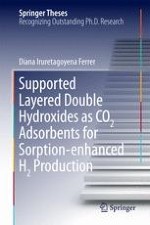2016 | OriginalPaper | Chapter
2. Literature Review
Author : Diana Iruretagoyena Ferrer
Published in: Supported Layered Double Hydroxides as CO2 Adsorbents for Sorption-enhanced H2 Production
Publisher: Springer International Publishing
Activate our intelligent search to find suitable subject content or patents.
Select sections of text to find matching patents with Artificial Intelligence. powered by
Select sections of text to find additional relevant content using AI-assisted search. powered by
